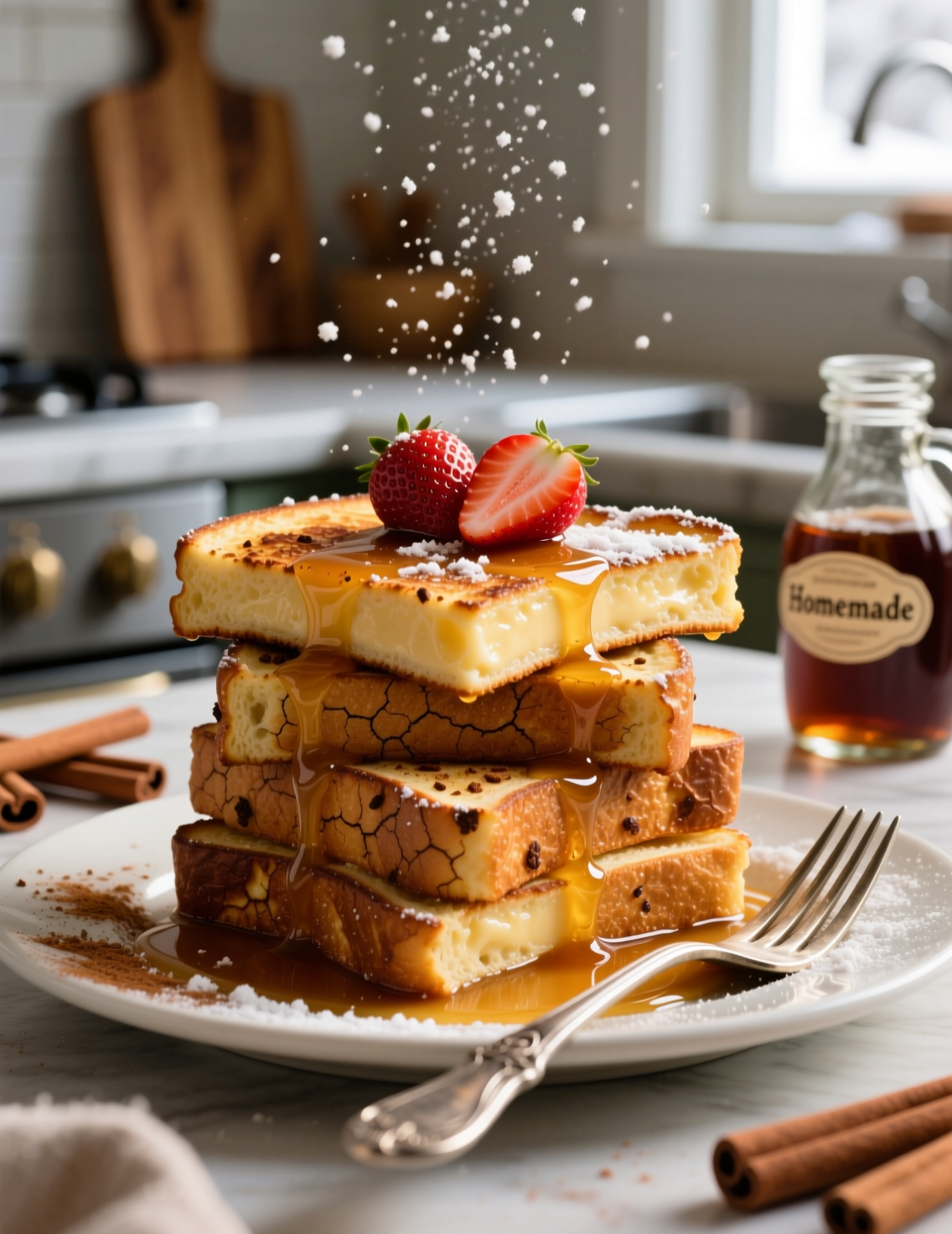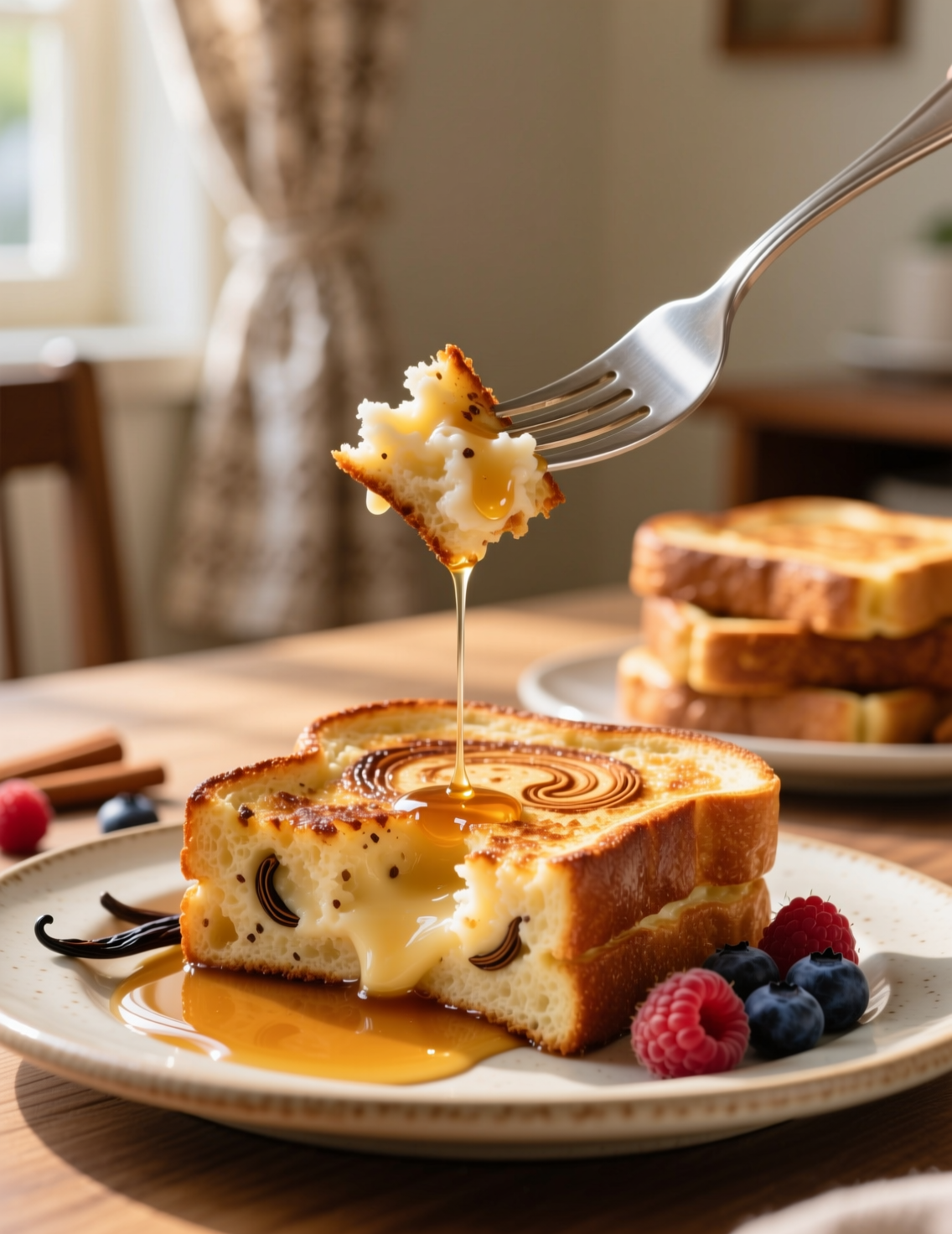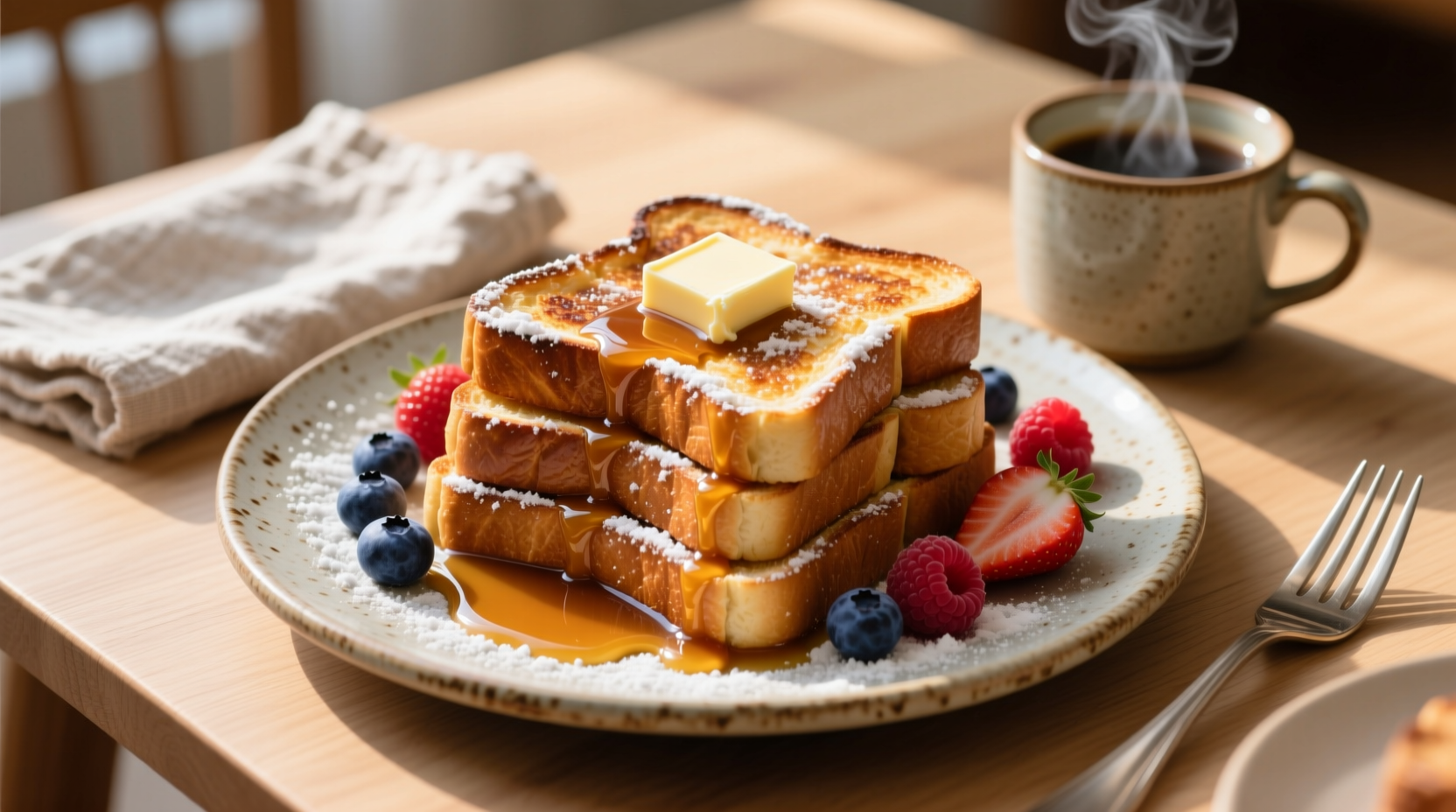There’s something quietly indulgent about a plate of French toast. Golden edges, soft custard inside, and the faint perfume of cinnamon and vanilla dancing in the air. This isn’t your average Sunday breakfast, no. This is an experience—a carefully balanced play of texture, aroma, and technique that turns a humble loaf of bread into a dish that could make even the most seasoned chef pause mid-bite.
French toast, or pain perdu (literally “lost bread”), was never meant to be fancy. But over time, it’s evolved from a thrifty way to use stale bread into a refined, comforting classic. This Ultimate Cinnamon Vanilla French Toast recipe for six is built to impress—whether you’re plating it in a restaurant brunch rush or serving your family on a lazy morning.
Let’s dive in, and not just into the recipe, but into the why—why this method works, why each ingredient matters, and how small tweaks can elevate your toast from good to unforgettable.
The Science Behind Perfect French Toast
At its core, French toast is custard-soaked bread fried in butter. Sounds easy. But the difference between soggy, heavy toast and one that’s airy with a crisp shell comes down to the ratio of liquid to egg, the type of bread, and how long you let it soak.
A traditional custard base uses roughly one egg for every two slices of bread. For six servings, we’ll go with 6 large eggs—rich enough to coat every bite without creating an eggy scramble. Whole milk and a bit of heavy cream bring the fat that gives that velvety texture. Professional chefs often swear by this balance: too little fat, and the bread dries out; too much, and it turns greasy.
Cinnamon and vanilla do more than add flavor. They awaken the brain—literally. According to a 2017 study from the Journal of Sensory Studies, the aroma of cinnamon has been linked to increased alertness and positive mood responses. Vanilla, meanwhile, has that round, creamy aroma that smooths everything out. Together, they’re comfort in molecular form.

Choosing the Right Bread
Here’s where most home cooks slip up. Bread isn’t just the canvas; it’s half the painting.
Brioche is the classic choice—rich, buttery, and soft enough to absorb custard like a dream. Challah works beautifully too, slightly denser with a subtle sweetness that complements the cinnamon-vanilla custard. If neither is available, use a thick-cut white bread but let it stale for a day or two. Fresh bread collapses under the weight of the custard. Stale bread holds its dignity.
Pro tip: slice your bread about ¾-inch thick. Too thin, and it falls apart; too thick, and the custard never reaches the center.
The Ingredients
For 6 servings, you’ll need:
- 12 slices brioche or challah (¾-inch thick)
- 6 large eggs
- 1 cup whole milk
- ½ cup heavy cream
- 3 tbsp granulated sugar
- 1 ½ tsp ground cinnamon
- 1 tbsp pure vanilla extract
- ¼ tsp salt
- 4 tbsp unsalted butter (for frying)
Optional (but oh so worth it):
- Maple syrup, powdered sugar, or fresh berries for garnish
That’s the base. Now let’s build it into something that sings.
Mixing the Custard
Crack the eggs into a wide bowl—something shallow enough for dipping the bread evenly. Whisk them until the yolks and whites fully combine. Then pour in the milk, cream, sugar, cinnamon, vanilla, and salt. Whisk again until smooth.
You’ll see little bubbles form—that’s a good sign. Air helps keep the custard light. But don’t overmix; you don’t want froth. A few turns of the whisk past “combined” is plenty.
Some chefs like to infuse their milk with a cinnamon stick and vanilla bean over low heat, then cool it before mixing. That’s not a bad move if you’ve got the time. It deepens the flavor, gives it that bakery scent that feels expensive somehow.
The Soaking Game
Here’s the thing: soaking time is everything. Dip your bread too quickly, and the custard won’t penetrate the center. Soak it too long, and it’ll fall apart before it even hits the pan.
For brioche or challah, 20 to 30 seconds per side is perfect. Let the slices sit on a wire rack afterward for a minute—this lets any excess custard drip off and prevents a greasy crust. If you’re batch-cooking for six, line them up like soldiers waiting for their turn in the pan.
The Cooking
Butter’s the key here, but it’s also the trap. Too high heat, and it’ll burn before the toast’s ready. Too low, and you’ll get a pale, soggy slab. The sweet spot? Medium heat, leaning slightly toward low.
Melt 1 tablespoon of butter in a nonstick or cast-iron skillet. When it foams but doesn’t brown, add two slices of soaked bread. Cook for about 3 minutes per side, until golden-brown with a slightly crisp edge.
Now, here’s a little insider trick: halfway through cooking, drop a tiny piece of butter next to the bread and tilt the pan to baste it. This gives you that glossy, caramelized crust that restaurant brunch plates always seem to have.
Keeping It Warm Without Drying It Out
If you’re making all six servings, you’ll be frying in batches. Transfer the cooked toast to a baking sheet and keep it in a 200°F oven. That’s just enough heat to keep it warm without toughening the custard. Don’t cover it with foil—it traps steam and kills your crunch.

The Flavor Tweaks That Change Everything
Now, for those who like to play a little.
Add a splash of dark rum or bourbon to the custard—it amplifies the vanilla and adds warmth that feels almost nostalgic. Or swap out granulated sugar for brown sugar for a hint of molasses depth. A pinch of nutmeg (just a pinch) brings the cinnamon to life.
For a more delicate variation, mix 2 tablespoons of mascarpone into the custard. It creates this creamy interior that feels like dessert but eats like breakfast.
The Art of the Finish
A good plate of French toast is layered—not just in flavor, but in texture and contrast.
Dust with powdered sugar right before serving. Not too early; it’ll dissolve into a wet film if you wait too long. Drizzle warm maple syrup over the top, letting it pool around the edges. Add fresh berries for acidity—they cut through the richness.
For something more dramatic, whip up a quick cinnamon-vanilla butter:
- ½ cup softened butter
- 1 tsp cinnamon
- 1 tsp vanilla extract
- 1 tbsp honey
Mix and dollop on top of each slice. Watch it melt into a glossy, aromatic sheen.
What Professionals Know (That Home Cooks Often Don’t)
Most chefs treat French toast like a test of control. It’s a slow dish, a patient one. Rushing it ruins everything.
Temperature is your silent partner here. The custard needs to be cold; the pan needs to be moderate. You want a Maillard reaction—that lovely browning—without scorching the surface.
Also, don’t overcrowd the pan. The steam from multiple slices lowers surface temperature and gives you a soft, uneven browning. Cook two, maybe three at a time.
Another often-missed detail? Resting. Like meat or cake, French toast benefits from a minute of rest before slicing or serving. The internal custard sets, locking in that creamy texture.
The Health Angle (Because Balance Matters)
A typical serving of this recipe (two slices) clocks in at around 350–400 calories depending on bread and toppings. While indulgent, it’s also a balanced source of protein, carbs, and fats.
To lighten it slightly, you can replace half the cream with low-fat milk or even unsweetened almond milk. Coconut milk adds a tropical twist that works well with the cinnamon.
Just don’t skip the fat completely. Without it, you lose the silkiness that makes French toast worth waking up for.
Why Cinnamon and Vanilla Are More Than Flavor
Beyond taste, cinnamon has real health benefits. It’s been shown in studies to help regulate blood sugar and reduce inflammation. Vanilla, interestingly, has antioxidant properties and can enhance perceived sweetness—meaning you might use less sugar overall.
This pairing isn’t just classic for nostalgia. It’s chemistry working in your favor.
Troubleshooting: When Things Go Wrong
If your French toast is soggy, your custard ratio’s too wet—or your soaking time’s too long. Cut the milk slightly next time or dry the bread a bit more.
If it’s too dry, you probably overcooked it or used bread that was too thin.
If the crust burns before the inside sets, lower the heat and preheat the pan less aggressively. Butter burns at 350°F; stay below that sweet line.
French Toast Around the World
Interestingly, every culture seems to have its version. The French have pain perdu, the Spanish torrijas, often soaked in wine and honey. In Hong Kong, they deep-fry it and serve it with peanut butter—chaotic, yet brilliant.
The common thread? A mix of thrift, comfort, and creativity. Which is what makes French toast endlessly reinventable.
Serving Ideas for the Pros
For a plated brunch menu, try stacking three triangles of toast, alternating with whipped cream and fresh berries, drizzled with cinnamon syrup. Garnish with a mint sprig for color contrast.
If you’re hosting a brunch buffet, keep slices warm on a chafing dish and serve with a toppings bar—syrups, nuts, caramelized bananas, or even a spiced whipped cream.
Want to go savory? Skip the sugar, add a bit of pepper and herbs to the custard, and top with smoked salmon and crème fraîche. It’s unexpected, and utterly delightful.
The Final Word
Making the perfect Cinnamon Vanilla French Toast isn’t about fancy ingredients. It’s about intention. Every step—from whisking the custard to basting the crust—builds towards that single bite that’s crisp at the edge and custardy in the middle.
In professional kitchens, French toast is a kind of meditation. It demands attention, rhythm, and just the right kind of restraint.
So the next time you’re in the kitchen, whisk in that cinnamon and vanilla with purpose. Let the bread drink slowly, sizzle patiently, and brown to that toffee gold. Then serve it hot, syrup glistening, butter melting, the air heavy with spice.
That’s not just breakfast. That’s art.
FAQs
What type of bread is best for French toast?
Brioche or challah works best because they’re rich, sturdy, and soak up the custard beautifully.
Can I use fresh bread instead of stale bread?
You can, but stale bread holds its shape better and won’t get soggy.
How long should I soak the bread in the custard?
About 20–30 seconds per side is perfect for brioche or challah.
What’s the ideal pan temperature for cooking French toast?
Medium heat, just enough to brown the butter without burning it.
Can I make the custard mixture ahead of time?
Yes, you can refrigerate it overnight for quick morning prep.
Why is my French toast soggy inside?
It’s likely over-soaked or the custard ratio has too much liquid.
Can I use non-dairy milk for this recipe?
Absolutely—almond, oat, or coconut milk all work well.
How do I keep French toast warm while cooking in batches?
Place finished slices in a 200°F oven until ready to serve.
What toppings go best with cinnamon vanilla French toast?
Maple syrup, powdered sugar, fresh berries, or whipped cinnamon butter.
Can I freeze leftover French toast?
Yes, freeze slices between parchment sheets and reheat in a toaster or oven.
Is this recipe suitable for large gatherings?
Yes, it scales easily and stays delicious when kept warm.
Can I make it healthier without losing flavor?
Use low-fat milk and less sugar, but keep a bit of fat for richness.
How do I prevent the butter from burning in the pan?
Cook on medium-low heat and add butter just before each batch.
What gives French toast its custardy center?
The balanced mix of eggs, milk, and cream cooked gently through.
Why add salt to the custard?
A pinch of salt enhances the sweetness and balances the flavors.

Mariana is a passionate home cook who creates delicious, easy-to-follow recipes for busy people. From energizing breakfasts to satisfying dinners and indulgent desserts, her dishes are designed to fuel both your body and hustle.
When she’s not in the kitchen, she’s exploring new flavors and dreaming up her next recipe to share with the Foodie Hustle community.

